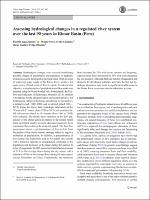Mostrar el registro sencillo del ítem
Assessing hydrological changes in a regulated river system over the last 90 years in Rimac Basin (Peru)
| dc.contributor.author | Vega-Jácome, Fiorella | |
| dc.contributor.author | Lavado-Casimiro, W. | |
| dc.contributor.author | Felipe-Obando, Oscar | |
| dc.date.accessioned | 2019-07-20T00:15:59Z | |
| dc.date.available | 2019-07-20T00:15:59Z | |
| dc.date.issued | 2018-04 | |
| dc.identifier.uri | http://repositorio.senamhi.gob.pe/handle/20.500.12542/44 | |
| dc.description.abstract | Hydrological changes were assessed considering possible changes in precipitation and regulation or hydraulic diversion projects developed in the basin since 1960s in terms of improving water supply of the Rimac River, which is the main source of fresh water of Peru’s capital. To achieve this objective, a trend analysis of precipitation and flow series was assessed using the Mann-Kendall test. Subsequently, the Eco-flow and Indicators of Hydrologic Alteration (IHA) methods were applied for the characterization and quantification of the hydrological change in the basin, considering for the analysis, a natural period (1920–1960) and an altered period (1961–2012). Under this focus, daily hydrologic information of the “Chosica R-2” station (from 1920 to 2013) and monthly rainfall information related to 14 stations (from 1964 to 2013) were collected. The results show variations in the flow seasonality of the altered period in relation to the natural period and a significant trend to increase (decrease) minimum flows (maximum flows) during the analyzed period. The Eco-flow assessment shows a predominance of Eco-deficit from December to May (rainy season), strongly related to negative anomalies of precipitation. In addition, a predominance of Eco-surplus was found from June to November (dry season) with a behavior opposite to precipitation, attributed to the regulations and diversion in the basin during that period. In terms of magnitude, the IHA assessment identified an increase of 51% in the average flows during the dry season and a reduction of 10% in the average flows during the rainy season (except December and May). Furthermore, the minimum flows increased by 35% with shorter duration and frequency, and maximum flows decreased by 29% with more frequency but less duration. Although there are benefits of regulation and diversion for developing anthropic activities, the fact that hydrologic alterations may result in significant modifications in the Rimac River ecosystem must be taken into account. | en_US |
| dc.format | application/pdf | |
| dc.language.iso | eng | en_US |
| dc.publisher | Springer-Verlag Wien | en_US |
| dc.relation.ispartof | urn:issn:0177-798X | |
| dc.rights | info:eu-repo/semantics/openAccess | es_PE |
| dc.rights | Attribution-NonCommercial-ShareAlike 3.0 United States | * |
| dc.rights.uri | http://creativecommons.org/licenses/by-nc-sa/3.0/us/ | * |
| dc.source | Servicio Nacional de Meteorología e Hidrología del Perú | es_PE |
| dc.source | Repositorio Institucional - SENAMHI | es_PE |
| dc.subject | Flow modeling | en_US |
| dc.subject | Hydrological change | en_US |
| dc.subject | Precipitation (climatology) | en_US |
| dc.subject | River flow | en_US |
| dc.subject | River system | en_US |
| dc.subject | Seasonality | en_US |
| dc.subject | Trend analysis | en_US |
| dc.subject | Peru | en_US |
| dc.subject | Rimac Basin | en_US |
| dc.title | Assessing hydrological changes in a regulated river system over the last 90 years in Rimac Basin (Peru) | en_US |
| dc.type | info:eu-repo/semantics/article | en_US |
| dc.identifier.isni | 0000 0001 0746 0446 | |
| dc.description.peerreview | Por pares | |
| dc.identifier.doi | https://doi.org/10.1007/s00704-017-2084-y | |
| dc.source.volume | 132 | es_PE |
| dc.source.issue | 1-2 | es_PE |
| dc.source.initialpage | 347 | es_PE |
| dc.source.endpage | 362 | es_PE |
| dc.source.journal | Theoretical and Applied Climatology | es_PE |
| dc.description.funding | The present study was made under the cooperation project between the National Hydrology and Meteorology Service of Peru (SENAMHI-PER?) and SEDAPAL, and it is supported by SENAMHI-PER?. The authors appreciate the facilities given by the Hydrology Department of SENAMHI. | es_PE |
| dc.subject.sinia | gestion de recursos hidricos de cuenca - Agua | |
| dc.type.sinia | text/publicacion cientifica | |
| dc.identifier.url | https://hdl.handle.net/20.500.12542/44 |
Ficheros en el ítem
Este ítem aparece en la(s) siguiente(s) colección(es)
-
Artículo científico [171]









